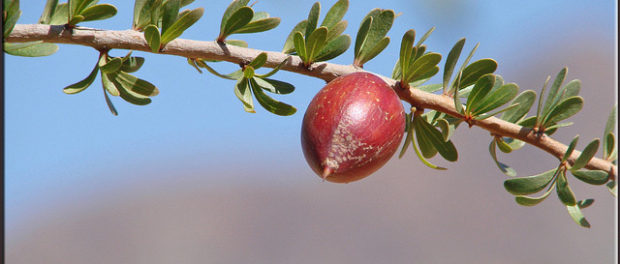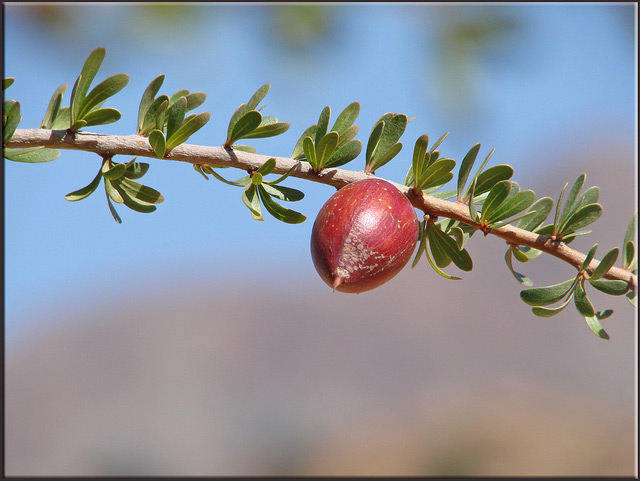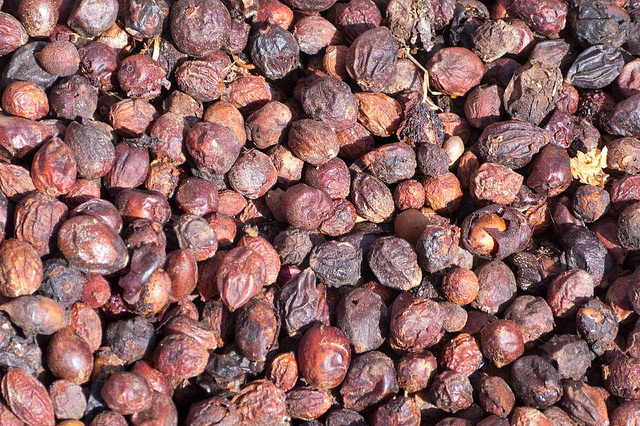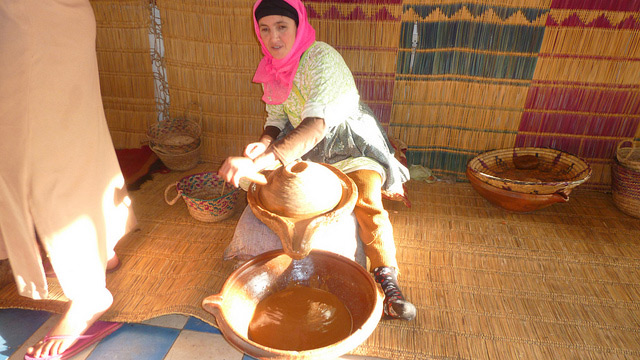11 Health Benefits of Argan Oil
 Argan oil is produced from the kernels of the argan tree!
Argan oil is produced from the kernels of the argan tree!
You must have already heard of Argan oil. It’s also known as Moroccan argan oil, simply because its country of origin is Morocco (Southeastern Morocco specifically). It is obtained by pressing the kernels of the Argan fruits. The Argan tree (Latin name Argania spinosa) is also known as the “Tree of Life”, name given by the ancient inhabitants of this area, the Berbers. Today the Argan tree grows in a couple of other locations in the world.
Thanks to its rich nutritional composition, Argan oil is one of the most powerful anti-aging oils in the world.
Today, Argan oil is marketed as a great oil for cosmetic applications, especially for the hair, nails, and skin, as well as for improving health. It is considered a beauty elixir that the Moroccan women have been using for centuries in their beauty rituals. In addition, an article published 2011 in the journal “Alternative Medicine Review” discusses its strong medicinal properties. [1]
There traditional way of obtaining Argan oil includes collecting undigested pits from the waste of the goats that have previous consumed fruits from the Argan tree. The next step is grounding and pressing the pits to extract the oil.

Argan oil is produced from the kernels of the argan tree!
Today, the fruits are harvested from the tree directly, and modern methods of extraction are used. First, the flesh of the fruits is either removed mechanically, or after being dried in open air. The Argan nuts are then cracked to obtain the kernels. The cracking has to be performed by hand which is a hard and time consuming job. That’s why the final product is one of the most valuable and relatively rare oil.
Culinary argan oil is obtained by mildly roasting the kernels and then by grounding and pressing. Cosmetic oil is obtained without roasting, to reduce the strong nutty flavor. Depending on the purity and clarity of the end product, there might be additional filtering to remove the solid material dissolved in the oil.
For cosmetic applications, the best possible Argan oil is the cold pressed, unfiltered oil.
Table of Contents
- 1 The Origin
- 2 Features
- 3 Health Benefits of Argan Oil
- 4 Benefits for the Hair
- 5 Homemade Acne Treatment
- 6 Prevents and Erases Wrinkles Naturally
- 7 Strengthens Weak and Brittle Nails
- 8 Health Benefits of Culinary Argan Oil
- 9 Anti-Cancer Action
- 10 Cardiovascular Action
- 11 Antidiabetic Action
- 12 Antioxidant action
- 13 Uses of Argan Oil
- 14 Possible Side Effects
- 15 Nutritional Information
- 16 Storage
- 17 Photo credits
- 18 References
- 19 Related Posts
The Origin
The shape of the Argan tree, Latin name “Argania Spinosa“, stands out in the barren landscape of Morocco. It attracts goats, which are known to climb the trees and feast on the fruits. The fruits are oval in shape and have a pulpy part hiding the strong fatty kernel inside.
Features
Argan oil has numerous strong healing properties. Some of them are related to the skin, hair, and nails, makin git suitable for cosmetic applications. Here is the list:
- Moisturizing action – Argan oil has good moisturizing properties.
- Wound healing action – Promotes the healing of wounds.
- Antioxidant action – Reduces the concentration of free radicals and prevents their damage both on the skin and inside the body.
- Anti-aging action – Keeps the skin healthy and strong if applied on a daily basis.
- Protective for the liver – Argan oil is can protect the liver.
- Cholerectic action – Stimulates the liver to increase the bile production.
- Anti-diabetic action – Argan oil can lower the blood glucose and improve the insulin resistivity, as demonstrated in animal trials.
- Chemopreventive – Reduces or delays the growth of cancer cells.
- Lipid lowering action – Argan oil improves the blood lipid profile.
- Cholesterol lowering action – It improves the levels of the good HDL cholesterol, at the same time preventing the oxidation of the bad LDL cholesterol.
Health Benefits of Argan Oil
Benefits for the Hair
Argan oil can be used to improve the condition of you hair. It helps make your hair more manageable and smoother. It is usually used by applying warm oil on wet hair and covering the scalp with a shower cap.
For optimal results, the oil should be kept for at least one hour. Some people leave the oil overnight, which imporoves the condition of the hair even more. You may even use small amounts of Argan oil before styling your hair.
Another, more traditional application is using a homemade shampoo. It helps with repairing dry hair ends. The argan oil shampoo should be prepared by mixing 1/2 cup of clean water with 1/4 cup of castile soap (based on olive oil and sodium hydroxide). Add to the mixture 1 spoon of argan oil. Don’t forget to shake the mix before use.
Homemade Acne Treatment
In home-based acne treatments, you can use Argan oil as a base oil to both reduce the sebum and to treat acne scars. Sebum is the way substance that lubricates the skin. It is produced by the microscopic glands in the skin.
You can make a home made acne oil by mixing 40 ml of cosmetic grade argan oil with 10 drops of tea tree oil. Either apply on the acne itself or smudge it on the entire affected area and wash off after a couple of minutes.
The comedogenic ratings tell us which oils are likely to clog pores and cause acne. A rating of 0 means that the oil is entirely safe. Argan oil belongs to this category, along with Hemp seed oil, sunflower oil, and shea butter. So, along with its overall health properties, it should be perfectly fine for treating acne or for healing acne scars.
Prevents and Erases Wrinkles Naturally
Due to the high concentrations of Vitamin E and other skin boosting nutrients, regular application Argan oil is great for reducing wrinkles and circles around the eyes.
Strengthens Weak and Brittle Nails
Argan oil can be sued to prepare a very simple home made remedy to help improve the strength of your weak nails. Argan oil is great to improve the strength, elasticity and thickness of your nails. Mix equal amounts of argan oil and freshly squeezed lemon juice and dip the tips of your fingers in this mixture for 10 minutes every day.
Other Topical Uses:
- Can be used to repair cracked heels. Soak the feet in argan oil for about 15 minutes a day.
- Argan oil is a fine brilliantine. It softens the hair, making it receptive to other cosmetic products.
- Glossy look of the skin. Just a couple of drops of argan oil can give a glossy look to your skin.

Argan seeds
Health Benefits of Culinary Argan Oil
Anti-Cancer Action
Argan oil has certain protective properties against cancer, as shown by recent medicinal studies. In particular, in case of prostate cancer [2], it may work toward inhibiting the growth of tumor cells. It is not clear, however, if this anti-cancer action can be extended to other types of cancer.
The anti-cancer bio-active nutrient in argan oil are substances like tocopherols [3], sterols, squalene, and polyphenols.
Cardiovascular Action
Your blood lipid profile is an indication of how healthy your cardiovascular system is. Consuming Argan oil improves the levels of the good HDL cholesterol, at the same time reducing the oxidized bad LDL cholesterol. It is not that LDL is bad per se, it is the oxidized LDL that causes a lot of damage. That way, Argan oil prevents the creation of arterial plaques, reducing the risk of heart diseases.
Antidiabetic Action
Argan oil has been found to reduce the spikes of blood sugar in the blood of experimental animals. Using it a culinary oil, preferably cold in salad dressings could be one of the factors in lowering the risks of developing insulin resistivity and diabetes. [4]
Antioxidant action
The antioxidant action of this oil is due to its high concentration of vitamin E, which is a form of natural antioxidant.

Processing argan oil
Uses of Argan Oil
We have considered some applications of Argan oil as a cosmetic oil, but it can also be used as a culinary oil. The smoke point of 215 degrees Celsius (420 F) makes it relatively good for frying.
Still, don’t use it for frying, use it cold as it will be the healthiest that way. In fact, there is very little justification to deep fry anything at all. It has a nutty taste, which is great if you like to prepare vegetable salads.
Possible Side Effects
Except for the potential allergic reactions with some people, there is very little information about the side effects of Argan oil. Rarely it can cause itching, rashes, inflammation, and a serious condition called bronchospasm [5].
Nutritional Information
The fatty-acid profile of Argan oil is as follows:
MUFA 47 %
PUFA 35 %
SFA 18 %
Here are some of the fatty acids in Virgin Argan oil [6]:
| Fatty acid | % | Type of fatty acid |
| Stearic Acid (18:0) | 5.8 % | Saturated fat |
| Palmitic Acid (16:0) | 12.7 % | Saturated fat |
| Palmitoleic Acid (16:1) | 0.08 % | MUFA |
| Oleic Acid (18:1) | 45.6 % | MUFA |
| Linoleic Acid (18:2) | 34.6 % | PUFA |
| Alpha Linolenic Acid(18:3) | 0.34 % | PUFA |
| Behenic Acid (22:0) | 0.05 % | Saturated fat |
The Mono-unsaturated fatty acids (MUFA) and the saturated fatty acids (SFA) are great, but the Poly-unsaturated fatty acids (PUFA) speak against heating this oil to high temperatures.
Vitamin E is one of the most abundant vitamins present in Argan oil. This fat soluble vitamin is in fact a whole family of compounds called tocopherols. In addition to vitamin A, we find the following health promoting trace compounds:
- Squalene: a natural organic compound used by the cosmetic industry primarily extracted from shark liver oil, also present in argan oil, rice bran, olives, and wheat germ. Squalene possesses anti-cancer properties, especially for the skin.
- Carotenes: powerful antioxidants and precursors of vitamin A.
- Polyphenols: for example, anti-inflammatory caffeic acid, vanillic acid, antioxidant oleuropein.
Storage
Argan oil is moderately resistant to randicity. Still, because it contains higher concentrations of MUFA and PUFA, you should keep it in the dark, far away from heat and light sources, preferably in a dark bottle.
Make sure you buy a quality Argan oil in the first place. Some oils are mixed with other cheap oils of poor quality, and may even contain harmful substances. The label should clearly say something like: “100% argan oil” or ” 100% argania spinosa kernel oil”. It should be cold pressed. If it is a 100% organic Argan oil, that should be an extra benefit.
Photo credits
References
- Argan Oil – Alternative Medicine Review; Dom Guillaume and Zoubida Charrouf http://www.altmedrev.com/publications/16/3/275.pdf
- Cancer Detection and Prevention; 2006. H. Bennani et al. http://arganicaoil.com/images/Research_paper_4.pdf
- Eur J Cancer Prev. 2003 Feb;12(1):67-75. Khallouki et. al. http://www.ncbi.nlm.nih.gov/pubmed/12548113
- Antidiabetic and antihypertensive effect of Virgin Argan Oil… Bellahcen S et al. http://www.ncbi.nlm.nih.gov/pubmed/23836726
- Common and Rare Side Effects for Hair, Skin and Nails-Argan Oil oral. http://www.webmd.com/drugs/2/drug-166286/hair-skin-and-nails-argan-oil-oral/details/list-sideeffects
- Characterization of Fatty Acid Profile of Argan Oil and Other Edible Vegetable Oils by Gas Chromatography and Discriminant Analysis, Rueda et.al. http://www.hindawi.com/journals/jchem/2014/843908/

Leave a comment